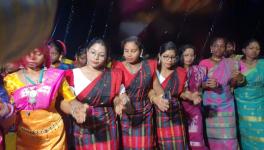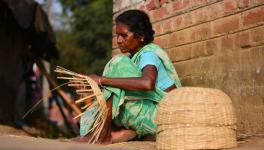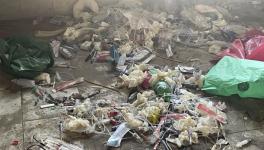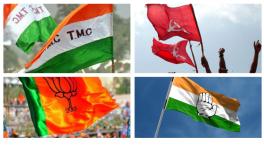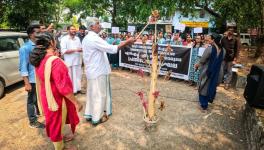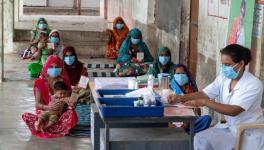Bengal: Insecurity, Exploitation Dog NHM Workers in Jangal Mahal
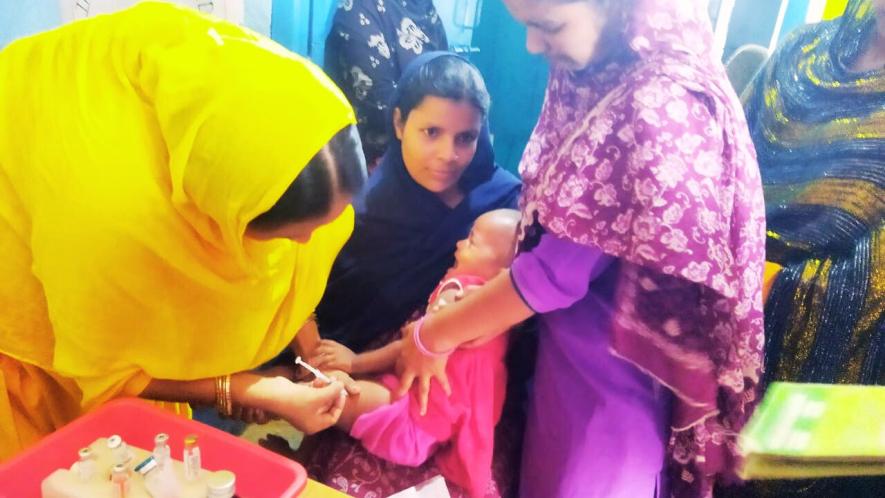
Immunisation programme by ASHA workers at Punisol in Onda block
Despite working for nominal salaries, National Health Mission (NHM) workers—including Accredited Social Health Activists (ASHA), doctors, nurses, health workers, and office staff—are facing rising job security and are operating in an environment of constant fear and a ‘culture of threat’. These workers provide essential healthcare services to patients daily, yet they are reportedly unable to sustain themselves financially and physically working under harsh conditions. Many of these workers have been complaining of mental and physically exhaustion. The question is: Is anyone paying attention to their plight?
Several workers this writer spoke with alleged that both the Central and state governments had shown little to no concern for their well-being. The government directives issued have only exacerbated the a ‘culture of fear’ within the NHM project in the state, which is worsening by the day.
Ironically, most patients and the public are unaware of the dire conditions under which these health workers operate. In fact, around 80% of the state's healthcare services are now provided through the NHM in West Bengal.
Introduction to NHM
The National Rural Health Mission (NRHM) was launched by the government of India on April 12, 2005, with the goal of providing quality, affordable, and accessible healthcare to the rural population, particularly women and children. Its objectives included improving access to healthcare, strengthening public health systems, promoting decentralisation, enhancing equity and accountability, and fostering community ownership of healthcare services.
In subsequent years, the National Urban Health Mission (NUHM) was launched to extend similar healthcare services to urban areas. Finally, on May 1, 2013, the Centre consolidated both missions under one banner—the National Health Mission (NHM). The NHM's purpose is to ensure that all citizens, regardless of location or income, have access to affordable, quality, and equitable healthcare services.
The mission's goals include reducing the maternal mortality rate (MMR), infant mortality rate (IMR), and the incidence and mortality of diseases, such as tuberculosis, malaria, and leprosy. NHM also aims to eliminate diseases such as kala-azar.
Currently, it is estimated that 80% of health services across India operate under NHM. In West Bengal's Jangal Mahal region, where many economically disadvantaged communities live in remote, forested, and hilly areas, healthcare services are heavily reliant on NHM workers. However, these health workers often operate in hazardous conditions and are not accorded the dignity and support they deserve from either the Central or state governments.

ANM 2 and ASHA health workers demanding their job security at CMOH office premises in Bankura.
This raises the question: Are these health workers receiving the recognition and support they need? If not, where does the problem lie? This issue deserves urgent attention.
The Role of NHM in Jangal Mahal
The NHM plays a critical role in providing healthcare services across the Jangal Mahal region. Although there are government medical colleges in all four districts of Jangal Mahal, the newly established colleges in Jhargram and Purulia reportedly lack the necessary infrastructure. Similarly, the Bankura and Medinipur medical colleges also face infrastructure challenges.
“These government medical colleges do not have enough doctors, nurses, and health workers. If a patient’s condition is even slightly complicated, they are referred to various medical colleges in Kolkata,” Dr. Utpal Banerjee, general secretary of the Association of Health Service Doctors, West Bengal, told this reporter.
Given the condition of these medical colleges, the situation in Block Health Centres, Primary Health Centres (PHCs), and village sub-centres is even more dire. For instance, the Ranibandh Block Health Centre and the Jhilimili and Holudkanali Primary Health Centres in Bankura, as well as the Bandoyan and Manbazar Block Health Centres in Purulia, and the Belpahari, Banspahari, and Lodhasuli Primary Health Centres, lack the minimum required number of doctors and health workers.
“People come here for treatment mostly out of compulsion,” said Tapan Mahato, a resident of Lodhasuli, Jhargram.
Several residents of these areas recall that under the previous Left Front regime, most PHCs offered indoor facilities. However, today, many of these PHCs no longer provide such services.
“There has been no appointment of permanent staff for the past 10 years. As a result, people are being deprived of the health services they should be receiving from these government institutions,” Santi Sarkar, a recently retired health worker from Bankura Medical College and Hospital, told this reporter.
Residents of Jangla Mahal rely almost entirely on NHM for their healthcare needs. Health workers under NHM are providing critical services to large populations in both villages and urban areas of Jangal Mahal, earning the trust and gratitude of the people. Unfortunately, however, none of these health workers have permanent employee status.
The NHM provides healthcare services that can be broadly categorised into four areas:
1. Communicable Diseases: Prevention and treatment of diseases such as tuberculosis, leprosy, and other infectious diseases.
2. Non-Communicable Diseases: Management of conditions such as hypertension, diabetes, and the prevention of cancers.
3. Vector-Borne Diseases: Treatment of diseases such as dengue and malaria.
4. Reproductive and Child Health: Services related to reproductive health, maternity care, newborn health checkups, and immunisation.
In addition, mental health services are also part of NHM's mandate.
Working Conditions of NHM Workers
“We, the health workers under various projects of NHM services, work at the risk of our lives, but there is no job security. Despite the Supreme Court’s mandate on ‘equal pay for equal work’, this principle is not applied here. Workers have to toil for a minimal pay, and despite years of service, our positions remain temporary,” said Abhik Mishra, ASHA Block Coordinator in Onda Block, Bankura.
Mishra said NHM workers were not even entitled to health insurance. In the event of an accident during work, the worker's family does not receive compensation. Additionally, there is no provision for gratuity or pension after retirement at the age of 60.
Several health workers pointed out that some of them receive as little as ₹8,000 per month, with most not earning more than ₹20,000. Only a few senior workers receive salaries above ₹50,000, and doctors are paid slightly more. Those workers responsible for transporting vaccines to health centres are paid meagre wages, often no more than ₹1,000 per month.
Golam Khaja Khan of Onda Block, Nirmal Ray of Inpur Block in Bankura, Santosh Murmu and Jotin Mahato of Bandoyan Block in Purulia, and Jiban Sardar of Belpahari Block in Jhargram, who work as vaccine carriers, mentioned that they transport vaccines from block health centres to local sub-centres. If they travel within 20 km, they receive only ₹90. They are assigned this task no more than four times a month. For distances exceeding 20 km, they are paid only ₹200.
The Auxiliary Nurse Midwives (ANM) are also integral to NHM, falling into two categories: ANM 1, appointed by the state government, and ANM 2, hired on a contractual basis by NHM.
“At the health centres, we perform the same duties, but our salaries are significantly lower than those of ANM 1. In addition to immunising mothers and children, we treat patients in the absence of doctors. Yet, we only earn ₹23,000 per month. Since 2009, no new ANM 2 appointments have been made, forcing us to work under tremendous pressure,” Ranu Mandal Giri, an ANM 2 at Hirapur Health Centre in Bankura, told this reporter.
ASHA workers are the backbone of the NHM. These female health workers provide healthcare services to every family in both urban and rural areas. They handle everything from new couples, pregnant women, lactating mothers, and children to elderly patients. In emergencies, they also manage health camps. Despite working around the clock, they receive a meagre monthly salary of ₹5,300.

A health camp at Belpahari in Jhargram District,
“We don’t regularly receive the incentives we are entitled to. After taking a pregnant woman to the hospital, no one checks how we return home or where we stay for the night,” said ASHA workers Mukta Mahato, Anjali Mahato from Raibandh, Johima Khatun, Rojina Bibi from Punisol (Bankura District), Ratna Tudu from Banspahari (Jhargram), and Monimala Sardar from Manbazar 2 Block (Purulia District). They also pointed out that the “Janani Suraksha 102” vehicles, which provide free transportation for pregnant women to hospitals, were in short supply, often leading to babies being born at home.
Due to the efforts of NHM workers, areas like the Ranibandh Block in Bankura—once identified as malaria-prone—have seen significant improvement. Tuberculosis, once widespread, has also been largely controlled. However, earlier this year, there was no supply of tuberculosis medicine for four months.
“We were extremely concerned, but the supply has since resumed,” said Sheikh Aamiruddin, an NHM health worker from Ranibandh. He said around 10-15 people, mostly male and female labourers, were still diagnosed with tuberculosis every month in Ranibandh.
Residents like Susanta Mahato, a farmer from the Barikul village in the dense forests of Ranibandh, attribute their recovery to the efforts of NHM workers. Middle-aged patients like Manju De said they continue to receive regular treatment for tuberculosis.
Despite their critical contributions, the number of NHM workers is far below the required level, forcing them to manage an overwhelming workload. Many health workers complained of facing “constant humiliation” during video conferences with officials at Swasthya Bhavan (the State Health Headquarters) in Kolkata.
Recently, a ‘culture of threat’ has become associated with this project, said many NHM workers. They said are monitored by the Chief Medical Officer of Health (CMOH) at the district level and the Block Medical Officer of Health (BMOH) at the block level. But, they are now under significant mental stress due to the Annual Performance Review (APR) system.
Over the past three years, the state government has adopted the APR directive of from the Union government without any hesitation. Every year, apart from ASHA workers, NHM employees—including doctors, data entry operators (now termed Executive Assistants), field workers, ANM 2, and others—are required to submit performance reports in a prescribed format. If the authorities are satisfied with an employee's performance, their contract may be renewed for another year.

ASHA workers in Bankura Junbedia sub-center.
Performance ratings are categorised as ‘Poor, Average, Good, Very Good, and Excellent’. Workers with ‘Poor’ ratings face termination, while those rated ‘Average’ receive a 3% salary increase. The top three categories receive a 5% salary increase.
“This system has created a clear distinction among workers, forcing them to prioritise pleasing the authorities in order to retain their jobs,” said Sandip Sarkar, an Executive Assistant from Nituria Block, Purulia District. He said workers were living with uncertainty about their evaluation parameters.
When asked about the working conditions, Dr. Shyamal Saren, CMOH of Bankura District, acknowledged some issues and said the authorities were trying to resolve them “within their capacity”. He praised NHM workers for their “responsible and dedicated service.”
The writer covers the Jangal Mahal region for ‘Ganashakti’ newspaper in West Bengal. The views are personal.
(All pictures by Madhu Sudan Chatterjee)
Get the latest reports & analysis with people's perspective on Protests, movements & deep analytical videos, discussions of the current affairs in your Telegram app. Subscribe to NewsClick's Telegram channel & get Real-Time updates on stories, as they get published on our website.









